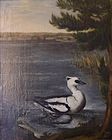Willem Frederik van Royen
Willem Frederik van Royen (* around 1645 in Haarlem ; † 1723 in Berlin ) was a Dutch painter.
Life
Van Royen was probably born in Haarlem. From around 1661 to 1668 he was a pupil of Arnold van Ravesteyn , who worked as a portrait and history painter in The Hague. It is possible that he was also a pupil of Melchior de Hondecoeter , since he painted still lifes and flowers similar to the latter , while such pictures by Ravesteyn are not known. This assumption is based on a mention from de Hondecoeter's biography in which a van Royen is named as an apprentice. Van Royen went to Berlin in 1669, where he succeeded the flower painter Adriaen van der Spelt , who returned to the Netherlands, and became court painter to Elector Friedrich Wilhelm . For his services he received free accommodation and an annual salary of 300 Reichsthalers. In 1679 his salary was increased by 200 thalers, but previously granted benefits in kind were no longer applicable. After Friedrich Wilhelm's death he worked for his successor, Elector Friedrich III , from 1701 as Friedrich I King of Prussia , which is why he moved to Potsdam in 1689 . In 1698 he became professor and rector at the Berlin Academy of the Arts, founded by Friedrich III and Augustin Terwesten in 1696 .
He should not be confused with the painter and draftsman in Amsterdam Willem van Royen (1672–1742), who mostly painted birds.
Works (selection)
On the painting Menagerie of Elector Friedrich III. from 1697/98, two rare spotted axis deer , two strange cassowaries , a snowy owl , a smaller bird and a black duck or goose can be seen. Van Royen also painted curiosities such as the anthropomorphic carrot, which was bought at a market in Berlin in July 1699, and other still lifes.
Still life with peaches and grapes, Ashmolean Museum
Flower vase, Fitzwilliam Museum
Dwarf soldiers on the Havel in front of Caputh, approx. 1685, Caputh Castle
Menagerie of Elector Friedrich III. , 1697 Caputh Castle
Web links
- Willem Frederik van Royen. Biographical data and works in the Netherlands Institute for Art History (Dutch)
Individual evidence
- ↑ a b Willem Frederiksz. van Royen (c. 1645-1723). In: Lieke Marije Janssen: Nederlandse bloemstillevenschilders in Berlijn; Nederlandse Hofkunstenaars in the service of keurvorst Friedrich Wilhelm van Brandenburg (1620–1688). academia.edu , June 24, 2015, pp. 62–65 , accessed on September 24, 2015 .
| personal data | |
|---|---|
| SURNAME | Royen, Willem Frederik van |
| ALTERNATIVE NAMES | Royen, Willem Fredriksz van |
| BRIEF DESCRIPTION | Dutch painter |
| DATE OF BIRTH | around 1645 |
| PLACE OF BIRTH | Haarlem |
| DATE OF DEATH | 1723 |
| Place of death | Berlin |





